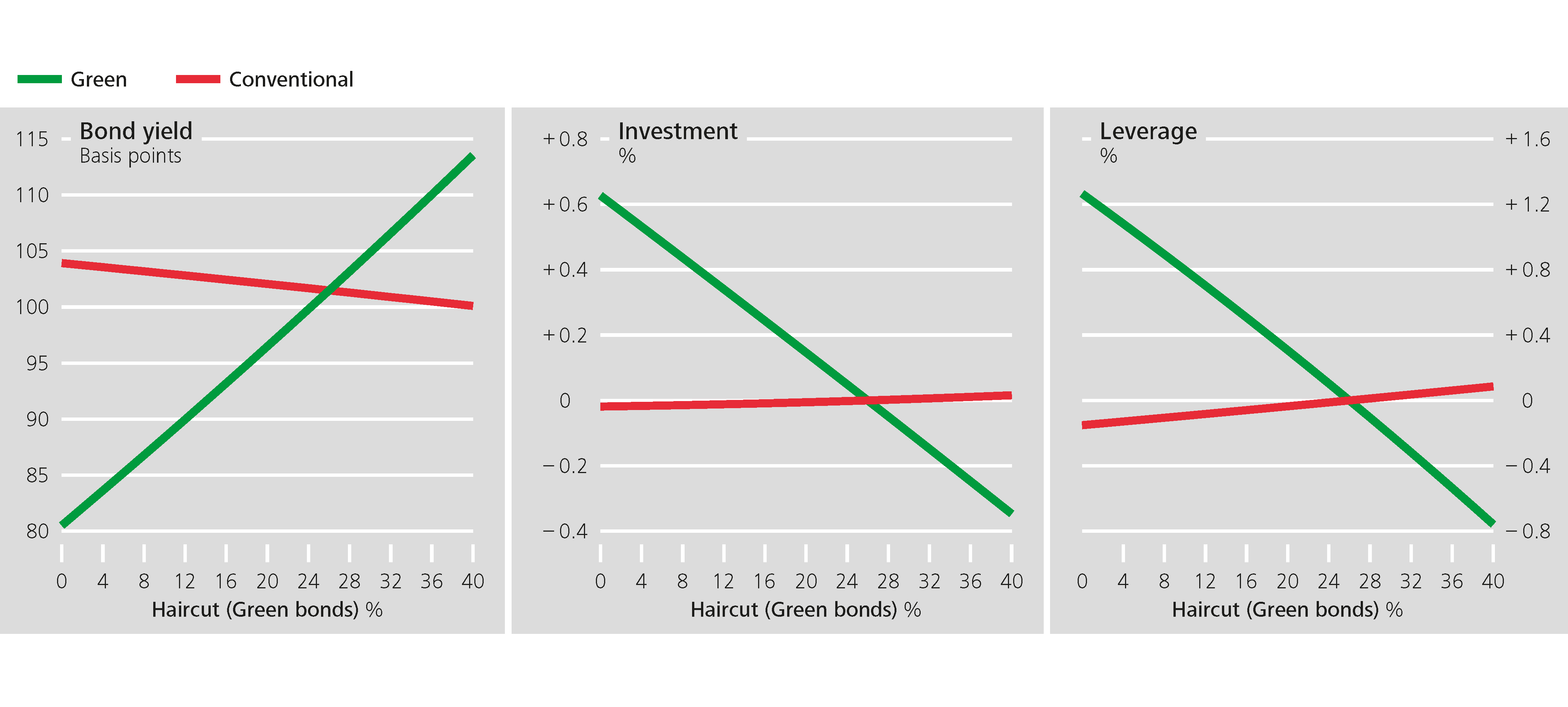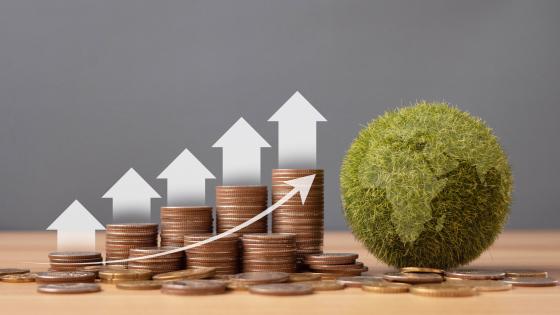Mitigating anthropogenic climate change will be one of the greatest economic policy challenges over the coming decades. Owing to the inadequate fiscal measures (such as carbon pricing) currently being taken (IPCC 2021), there have recently been calls on investors in general, and central banks in particular, to proactively combat climate change (Brunnermeier and Landau 2020, Diggle and Bartholomew 2021). Since its 2021 strategy review, the ECB has included climate objectives in its monetary policy, provided this does not conflict with the primary mandate of price stability (ECB 2021). In our study (Giovanardi et al. 2022), we investigate whether the preferential treatment of green bonds in the collateral framework can be a suitable environmental policy instrument.
We develop a dynamic stochastic general equilibrium model in which firms finance their activities by issuing equity or by issuing debt in the form of corporate bonds. They thus decide on their funding structure. The bonds are held by banks which, in turn, can post them to the central bank as collateral for short-term loans. Since bonds carry default risk, central banks accept corporate bonds as collateral only subject to a haircut. For a bank, the lower the central bank haircut, the more valuable a bond is. As banks are competitive, firms issuing bonds with small haircuts can obtain cheaper funding.
In our model, there are two types of firms that issue bonds: conventional and green. Conventional firms generate greenhouse gas (GHG) emissions during the production process, which give rise to macroeconomic costs given their contribution to global warming. However, these costs are not borne by firms but by the general public. Emissions are therefore a negative externality. By contrast, green firms do not emit GHGs in their production process.
If the central bank applies a smaller haircut to bonds issued by green firms than to those issued by comparable conventional firms, green bonds become more appealing from the banks’ perspective, given their increased collateral value. Banks therefore increase demand for them. Green firms change their capital structure, issue more bonds and increase their investment (for positive effects of credit supply on green investment, see Tomasi et al. 2022). The aggregate share of green investment in the economy rises, implying that GHG emissions fall. However, the leverage ratio of green firms also increases, which ultimately leads to rising default risk for green bonds.
This undesirable side effect on debt sustainability does not occur in the case of a carbon tax, as this only affects the attractiveness of investment in physical capital, but does not increase the attractiveness of bonds relative to equity financing. As a result, in our model framework, a carbon tax leads to a much better result in macroeconomic terms than a green collateral policy. As soon as emissions are priced to maximise welfare, there is no argument in our model in favour of a green-tilted collateral policy.
In qualitative terms, these results are unsurprising. We therefore use our model to make a quantitative estimate of the size of these effects. Our quantitative analysis is based on euro area data from 2010–2019, and the results are shown in Figure 1.
Figure 1 Effects of green haircuts on bond yields, investment, and leverage
Source: Deutsche Bundesbank.
Starting from a haircut of 26% on corporate bonds with a residual maturity of five years and a BBB rating (green line), the yield on green bonds would fall by around 20 basis points if the haircut were reduced to zero (Figure 1, left panel). As a result of this reduction in financing costs, green firms issue more bonds. In the model, green investment increases only by around 0.6% if the relevant haircut drops to zero (Figure 1, middle panel). Thus, not all proceeds from issuing bonds are invested. Some of the proceeds are used to increase dividends, meaning that the relevant firms’ leverage ratio rises and debt sustainability decreases (Figure 1, right panel). This is consistent with the empirical literature, such as Grosse-Rueschkamp et al. (2019), Todorov (2020), Macaire and Naef (2022), Eliet-Doilet and Maino (2022) and Chen et al. (2022).
Since the positive effect on green investment outweighs the negative effect on debt sustainability, green-tilted collateral policy can indeed have a welfare-enhancing effect in our model. However, two points must be considered. First, imprecise calibration of the haircuts may lead to welfare losses, for example if conventional bonds have such a large haircut that the total amount of collateral becomes too low. Second, the impact of a green collateral policy on the share of green investment is fairly small. As the difference between green and conventional bond yields under the welfare-maximising collateral policy is only 18 basis points, the increase in green investment is smaller than required from an environmental policy perspective – by a factor of around 100. It is impossible to induce the necessary share of green investment through preferential collateral treatment of green bonds, as the haircuts on green bonds cannot be smaller than zero and those on conventional bonds cannot be greater than 100%.
Our macroeconomic analysis abstracts from bonds whose payment structure is directly dependent on emissions (sustainability-linked bonds). This may affect the quantitative conclusions about the expected effects, but the qualitative conclusions of our analysis remain unaffected. Furthermore, the mechanisms discussed here are also applicable to asset purchase programmes (Nerlich et al. 2022) and banks’ capital requirements because in these cases, too, monetary policy and regulatory instruments influence demand for corporate bonds and loans. Finally, our analysis focuses on medium-term effects and does not explicitly discuss implications for the primary mandate of price stability.
Conclusion
Under certain assumptions, the preferential treatment of green bonds in the central bank’s collateral portfolio has a welfare-enhancing effect. However, owing to undesirable side effects on the leverage ratio of green firms, this policy is a qualitatively and quantitatively imperfect substitute for carbon taxation. If the current collateral framework underestimates transition risks and physical risks of conventional firms, the haircuts on those firms’ bonds should of course be increased. In that case, however, the relative preferential treatment of green bonds would be a risk management instrument of the central bank intended to prevent climate change from having negative effects on monetary policy operations (for a similar point on bank capital regulation, see Alessi et al. 2023).
References
Alessi, L, E Di Girolamo, P Giudici and A Pagano (2023), “Banks’ exposures to high-carbon assets may represent a medium-term vulnerability for the financial system”, VoxEU.org, 22 January.
Brunnermeier, M and J Landau (2020), “Central banks and climate change”, VoxEU.org. 15 January.
Diggle, P and L Bartholomew (2021), “Climate change and central banks: The case for violating neutrality”, VoxEU.org, 12 August.
ECB (2021), “ECB presents action plan to include climate change considerations in its monetary policy strategy”, press release, 8 July.
Eliet-Doillet, A and A Maino (2022), “Can Unconventional Monetary Policy Contribute to Climate Action?”, unpublished manuscript.
Chen, H, Z Chen, Z He, J Liu and R Xie (2022), “Pledgeability and Asset Prices: Evidence from the Chinese Corporate Bond Markets”, Journal of Finance, forthcoming.
Giovanardi, F, M Kaldorf, L Radke and F Wicknig (2022), “The Preferential Treatment of Green Bonds”, Deutsche Bundesbank Discussion Paper No 51/2022.
Grosse-Rueschkamp, B, S Steffen and D Streitz (2019), "A Capital Structure Channel of Monetary Policy”, Journal of Financial Economics 133: 357-378.
IPCC – Intergovernmental Panel on Climate Change (2021), “Summary for Policymakers”, in Climate Change 2021: The Physical Science Basis. Contribution of Working Group I to the Sixth Assessment Report of the Intergovernmental Panel on Climate Change.
Macaire, C and A Naef (2022), “Greening Monetary Policy: Evidence from China”, Climate Policy 23(1): 138-149.
Nerlich, C, M Ferdinandusse, A Ludwig and R Abiry (2022), "Green QE and carbon pricing: Looking at potential tools to fight climate change”, VoxEU.org, 7 October.
Todorov, K (2019), “Quantify the Quantitative Easing: Impact on Bonds and Corporate Debt Issuance”, Journal of Financial Economics 135(2): 340-358.
Tomasi, M, E Garcia-Appendini, G Barboni, M Cascarano and A Accetturo (2023), “Credit Supply and Green Investment”, VoxEU.org, 1 December.








